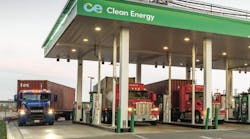Today U.S. Transportation Secretary Norman Y. Mineta urged American businesses to invest in highway infrastructure after he rang the opening bell at the NASDAQ stock market in New York. His visit to the exchange came just one week after the Dept. of Transportation (DOT) unveiled a national initiative aimed at unclogging highway and freight congestion.
“We know that many private firms are literally knocking on doors in state capital across the country, willing to invest billions of dollars in transportation projects…while many of these firms are international, we believe that transportation infrastructure will be an increasingly attractive opportunity for American investors,” Mineta said at NASDAQ.
The plan, known as the National Strategy to Reduce Congestion on America’s Transportation Network, makes only modest recommendations to increase roadway capacity, favoring instead to introduce new tolling schemes that discourage driving during peak hours. Expanded public-private infrastructure agreements were a sticking point to generate more revenue.
To view the congestion reduction plan, go to http://isddc.dot.gov/OLPFiles/OST/012988.pdf.
“The plan itself calls upon the leadership of the Department to establish Urban Partnership Agreements with selected communities and encourages states to pass legislation giving the private sector a broader role in investing in transportation,” stated Mineta in the report.
To support the “road-pricing” proposal, which refers to indexing toll prices to the amount of congestion, DOT pointed to London, England and Stockholm, Sweden as model examples which improved throughput immediately since its implementation. DOT intends to assess its effectiveness in the United States by securing agreements with cities.
Through such local agreements, DOT said it will expedite the completion of the most effective high-capacity projects that are currently under construction.
A separate but related “Corridors of the Future” initiative will identify three to five major growth corridors most in need of long-term investment to expedite capacity improvements. This also calls for bolstering multi-state cooperation for such corridors and “fast-tracking” corridors which received funding in the highway bill reauthorized in August.
DOT seeks to organize an effort to encourage states to enact legislation enabling them to enter into infrastructure agreements with the private sector. The Department noted the $1.8 billion 99-year lease of the Chicago Skyway and the pending $3.8 billion 75-year lease of the Indiana Toll Road reflect significant private investment potential.
In addition, DOT is seeking to encourage states to develop methods to disseminate real-time traffic information to all road users.
“[The strategy] talks about congestion management—which really means…to discourage people from driving at certain time of the day or even from driving altogether,” Brian Deery, senior director of highway and transportation division of the Associated General Contractors of America told FleetOwner. “There’s some talk about adding capacity here and there but it’s not the main emphasis. The proposed solution is part of the tool kit, but it’s not a comprehensive plan to address the problem.”
Mineta called congestion among the single largest threats to the economy, with the United States now losing about $200 billion a year due to freight bottlenecks and delayed deliveries. About 2.3 billion gallons of fuel is wasted annually by traffic jams.
The American Trucking Assns. (ATA) has declined to comment on the DOT initiative. ATA estimates trucking will haul 13 billion tons of freight by 2016—a 33% increase compared with 9.8 billion tons in 2004. By 2016, ATA projects 3.7 million 18-wheelers will be operating in the United States, up from 2.7 million in 2004.




